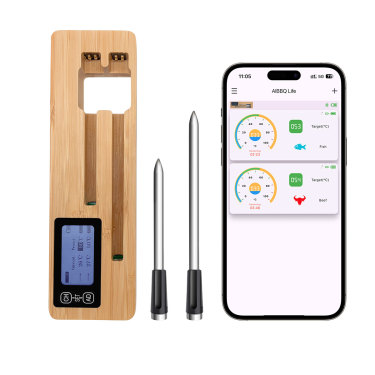
# Digital Meat Thermometer: The Essential Tool for Perfect Cooking
## Why Every Home Cook Needs a Digital Meat Thermometer
Cooking meat to perfection is both an art and a science. While experience plays a significant role, even the most seasoned chefs rely on precise temperature measurements to ensure food safety and optimal taste. This is where a digital meat thermometer becomes indispensable.
Unlike traditional analog thermometers, digital versions provide instant, accurate readings that take the guesswork out of cooking. Whether you’re grilling steaks, roasting a turkey, or smoking brisket, this tool helps you achieve consistent results every time.
## How Digital Meat Thermometers Work
Digital meat thermometers use advanced temperature sensors to measure the internal temperature of your food. Most models feature:
– A sharp probe that penetrates meat easily
– A digital display that shows temperature instantly
– Fast response times (typically 3-5 seconds)
– Temperature range suitable for all types of meat
The best models offer additional features like programmable alarms, backlit displays for low-light conditions, and even wireless connectivity to your smartphone.
## Key Benefits of Using a Digital Meat Thermometer
### 1. Food Safety Assurance
Undercooked meat can harbor dangerous bacteria like Salmonella and E. coli. A digital thermometer ensures your food reaches safe internal temperatures:
– Poultry: 165°F (74°C)
– Ground meats: 160°F (71°C)
– Pork and beef: 145°F (63°C) with 3-minute rest
– Fish: 145°F (63°C)
### 2. Perfect Doneness Every Time
Whether you prefer your steak rare (120-130°F) or well-done (160°F+), a digital thermometer helps you hit the exact temperature you want without overcooking.
### 3. Prevents Overcooking
By monitoring internal temperatures precisely, you can remove meat from heat at the perfect moment, preventing the dryness that comes with overcooking.
## Choosing the Right Digital Meat Thermometer
Keyword: digital meat thermometer
When selecting a digital meat thermometer, consider these factors:
– Probe type (instant-read vs. leave-in)
– Temperature range (-58°F to 572°F is ideal)
– Response time (faster is better)
– Waterproof design for easy cleaning
– Battery life and replacement options
– Additional features like timers or connectivity
## Tips for Using Your Digital Meat Thermometer Effectively
To get the most accurate readings:
– Insert the probe into the thickest part of the meat, avoiding bones and fat
– For thin cuts, insert the probe sideways
– Clean the probe thoroughly after each use
– Calibrate your thermometer periodically
– Let the thermometer adjust to room temperature before use if stored in extreme conditions
## Advanced Techniques with Your Digital Thermometer
Beyond basic temperature checks, skilled cooks use digital thermometers for:
– Monitoring smoker or grill temperatures
– Testing oil temperature for frying
– Checking bread and pastry doneness
– Making candy and chocolate
– Monitoring homebrewing processes
## Maintenance and Care
Proper care extends your thermometer’s lifespan:
– Always clean the probe with warm, soapy water
– Avoid submerging the display unit unless it’s waterproof
– Store in a protective case to prevent damage
– Replace batteries as needed
– Check accuracy periodically with ice water (32°F/0°C) or boiling water (212°F/100°C at sea level) tests
## The Bottom Line
A digital meat thermometer is one of the most valuable tools in any kitchen. It takes the mystery out of cooking meat, ensures food safety, and helps you achieve restaurant-quality results at home. Whether you’re a weekend griller or a serious home chef, investing in a quality digital thermometer will elevate your cooking game and give you confidence in the kitchen.